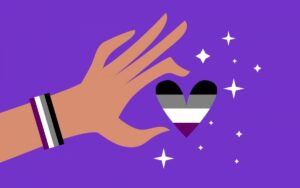In the spectrum of human sexuality, asexuality often stands misunderstood or even overlooked. Our task here is to shed light on these myths, elucidating the nuanced nature of asexuality and enhancing the broader understanding of this sexual orientation. In this blog post, we will debunk the most common myths about asexuality, bringing forward the real experiences and feelings of asexual individuals.
Contents
- 1 10 Common Myths About Asexuality
- 1.1 Myth 1: Asexuality is a disorder
- 1.2 Myth 2: Asexuality is a phase or a choice
- 1.3 Myth 3: They can’t love or maintain relationships
- 1.4 Myth 4: These people just haven’t met the right person yet
- 1.5 Myth 5: Asexuality and celibacy are the same
- 1.6 Myth 6: All asexual people are aromantic
- 1.7 Myth 7: It’s a result of trauma or abuse
- 1.8 Myth 8: Asexual people never have sex
- 1.9 Myth 9: Asexuality means a lack of libido
- 1.10 Myth 10: They are just trying to be ‘special’ or ‘different’
- 2 Consequences Of These Myths About Asexuality
- 3 Conclusion
10 Common Myths About Asexuality
 As we take strides in acknowledging the vast spectrum of human sexuality, it’s imperative to dispel common misconceptions about asexuality. Let’s journey into the realm of this often misunderstood sexual orientation, and debunk some prevalent myths about asexuality.
As we take strides in acknowledging the vast spectrum of human sexuality, it’s imperative to dispel common misconceptions about asexuality. Let’s journey into the realm of this often misunderstood sexual orientation, and debunk some prevalent myths about asexuality.
Myth 1: Asexuality is a disorder
Truth: This is a common misunderstanding, but it’s essential to know that asexuality is not a medical or psychological disorder. The Diagnostic and Statistical Manual of Mental Disorders, Fifth Edition (DSM-5). That is the reference for psychiatric diagnoses and does not list asexuality as a disorder. Rather, it is a legitimate sexual orientation on the spectrum of human sexuality.
Asexuality does not involve distress or dysfunction, the hallmarks of a disorder. Instead, it is simply characterized by a lack of sexual attraction toward others.
Myth 2: Asexuality is a phase or a choice
Truth: Asexuality, like heterosexuality, homosexuality, or bisexuality, is not a temporary phase or a lifestyle choice. Asexual people aren’t asexual because they decide to be, but because it reflects their inherent identity. It’s not something they ‘grow out of’ or ‘choose’ – it is simply a part of who they are. This myth stems from the misconception that asexuality is abnormal, a misunderstanding we hope to correct.
Myth 3: They can’t love or maintain relationships
Truth: Asexuality refers to the absence of sexual attraction, but this doesn’t mean that asexual individuals are incapable of loving or maintaining relationships. Asexual people often have the same emotional needs as anyone else and can form deep emotional and romantic bonds with others.
There are many types of love beyond sexual love, and asexual individuals may still desire and thrive in romantic relationships, familial relationships, and friendships. Also, some asexual people are in successful relationships with non-asexual individuals, highlighting that sexual attraction is not the only basis for a loving, fulfilling relationship.
Myth 4: These people just haven’t met the right person yet
Truth: This myth is tied to the idea that sexual attraction will automatically arise when the ‘right person’ comes along. Asexuality, however, isn’t about not finding the right partner; it’s about not experiencing sexual attraction. This orientation is independent of the people asexual individuals meet or the relationships they form. It’s important to respect this identity and not dismiss it as a case of not yet meeting the right person.
Myth 5: Asexuality and celibacy are the same
 Truth: Asexuality is a sexual orientation characterized by a lack of sexual attraction to others. Celibacy, on the other hand, is the conscious choice to abstain from sexual activity. While some asexual people may choose to be celibate, not all celibate people are asexual. The key difference is that asexuality is an inherent part of a person’s identity, while celibacy is a personal decision that isn’t tied to one’s sexual orientation. So, while they can overlap, they are distinctly different concepts.
Truth: Asexuality is a sexual orientation characterized by a lack of sexual attraction to others. Celibacy, on the other hand, is the conscious choice to abstain from sexual activity. While some asexual people may choose to be celibate, not all celibate people are asexual. The key difference is that asexuality is an inherent part of a person’s identity, while celibacy is a personal decision that isn’t tied to one’s sexual orientation. So, while they can overlap, they are distinctly different concepts.
Myth 6: All asexual people are aromantic
Truth: Asexuality and aromanticism are distinct but sometimes overlapping identities. Asexuality refers to the lack of sexual attraction to others, while aromanticism is characterized by a lack of romantic attraction. Some asexual people may identify as aromantic, meaning they experience neither sexual nor romantic attraction. However, many asexual people do experience romantic attraction and form romantic relationships. They may identify as heteroromantic, homoromantic, biromantic, panromantic, or other romantic orientations, demonstrating that asexuality and romantic attraction are separate dimensions.
Myth 7: It’s a result of trauma or abuse
Truth: This misconception can be quite harmful as it wrongfully implies that asexuality is a pathological response to a traumatic event, which is not the case. While some asexual individuals may have experienced trauma or abuse, these experiences are not a cause of asexuality. Asexuality, like any other sexual orientation, is not determined by past events but is an inherent part of a person’s identity. Linking asexuality with trauma can contribute to stigmatization and invalidate the identities of asexual individuals.
Myth 8: Asexual people never have sex
Truth: Asexuality is characterized by a lack of sexual attraction, but this does not necessarily mean asexuality equates to a lack of sexual activity. Some asexual individuals might choose to engage in sexual activities for various reasons. These could include pleasing their partner, creating an emotional bond, or wanting children. The key here is that they typically don’t experience sexual attraction, even if they choose to engage in sexual activities. Everyone’s experience with asexuality is different and personal.
Myth 9: Asexuality means a lack of libido
Truth: Asexuality refers to the lack of sexual attraction to others, not to the absence of libido or sexual desire. Sexual desire is a physical response or craving, often related to hormones and overall health. Some asexual individuals may experience libido, but it’s not directed toward other people. This is a crucial distinction as asexuality is about attraction and not about sexual drive or sexual behaviour.
Myth 10: They are just trying to be ‘special’ or ‘different’
Truth: Asexuality is an authentic orientation, not a bid for attention or an attempt to stand out. Every individual’s experiences with their sexuality are personal and complex. Discrediting asexual people’s experiences as seeking attention is both dismissive and disrespectful. Understanding and acceptance of asexuality, like any sexual orientation, is vital for the promotion of inclusivity and respect in society.
By debunking these myths about asexuality, we aim to create a better understanding of asexuality, fostering a more inclusive society that respects and validates all sexual orientations. Remember, the key to understanding and acceptance lies in respectful conversation and continuous learning.
Consequences Of These Myths About Asexuality
 The perpetuation of myths and misconceptions about asexuality can have several detrimental consequences for asexual individuals and society as a whole:
The perpetuation of myths and misconceptions about asexuality can have several detrimental consequences for asexual individuals and society as a whole:
- Stigmatization and Discrimination
Myths often foster misunderstanding and prejudice, leading to the stigmatization and discrimination of asexual individuals. They may be ostracized or invalidated by peers, families, and communities who do not understand their orientation.
- Mental Health Impact
Experiencing discrimination or feeling invalidated can lead to mental health problems such as depression, anxiety, or low self-esteem among asexual people. This can be especially exacerbated if they are made to feel that their orientation is a disorder or a phase.
- Identity Erasure and Invisibility
Many myths contribute to the erasure or invisibility of asexual identities, leading to a lack of representation in media, education, and even within LGBTQ+ spaces. This invisibility can lead to feelings of isolation and misunderstanding.
- Lack of Support and Resources
With myths and misconceptions being so prevalent, many professionals in health, education, or counseling fields may lack the understanding necessary to provide appropriate support for asexual individuals. This can lead to harmful or ineffective care, treatment, or advice.
- Internalized Asexuality Negativity
These myths can also lead to what is known as “internalized asexuality negativity,” where asexual individuals internalize society’s negative attitudes toward asexuality. This can result in self-doubt, self-denial, or self-loathing.
- Harmful Expectations and Pressure
Myths like “you just haven’t met the right person yet” or “it’s just a phase” can put undue pressure on asexual individuals to conform to societal norms and expectations. This can lead to distress and the feeling of needing to change oneself.
- Difficulty in Acceptance and Coming Out
Myths about asexuality can make it difficult for people to understand and accept their asexual identities. It can also make the process of coming out more challenging due to fear of disbelief, ridicule, or rejection.
By debunking these myths and promoting understanding, acceptance, and inclusivity, we can help mitigate these harmful effects and build a society where everyone, regardless of their sexual orientation, is respected and valued.
Conclusion
In conclusion, dismantling the many misconceptions surrounding asexuality is critical for the validation and acceptance of asexual individuals. Asexuality, as with any sexual orientation, is a deeply personal aspect of one’s identity. It is essential to approach this topic with empathy, understanding, and respect. By doing so, we can ensure asexual individuals feel seen, heard, and validated.
Remember, everyone’s experience with their sexuality is unique and personal, and all should be treated with respect and acceptance. Life may sometimes be challenging for asexuals, but Online Asexual Counseling can help. Get experienced LGBTQ therapists at PrideMantra: Book a trial LGBTQ therapy session


